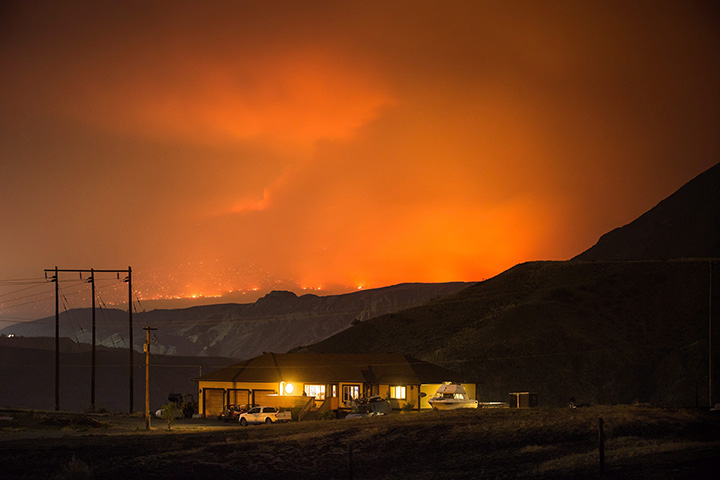This year saw many devastating weather events around the world including multiple back-to-back hurricanes, a heavy monsoon season that led to major flooding in India, and wildfires across the globe.

But that’s not to say Canada didn’t have its share of major weather in 2017.
From the long-lasting wildfires in B.C. to the winter storms that ripped the roofs off houses in Newfoundland, Environment Canada estimates the weather cost the governments millions of dollars.
FULL COVERAGE: 2017 year in review
There were over 113,000 insurance claims related to weather over this past year.
“We think of this happening on the other side of the world or south of the border, but we also had moments that beat us up, it punished us, it caused a lot of grief to people,” Environment Canada senior climatologist Dave Phillips told Global News.
According to the data, it was the eighth warmest year out of the 70 years on record; 1.4 C warmer than average. It’s also the 21st consecutive year that has been warmed than the year before it.
Environment Canada says Canadians are seeing and becoming vulnerable to more extreme weather, and warns that we need to adapt to keep up.
“This is not the weather your grandparents had. … We’ve seen the climate has changed, we need to change too. To build up our defences and our infrastructure,” Phillips said.
Here are Environment Canada’s top 10 weather stories of 2017:
1. B.C. wildfires

WATCH ABOVE: Smoke from BC wildfires obscures the sun in Vancouver
B.C.’s driest summer ever led to the longest and most disastrous wildfire season in the province in 2017.
The season was compounded by spring rains and erratic winds.
Over 50,000 people were evacuated from the southern B.C. interior, and over 300 structures burned, prompting the first province-wide state of emergency in 15 years.
WATCH: Amateur video captures scales of wildfire in Hanceville, BC

2. Dry and hot in the west
The summer in the Canadian West from the B.C. interior to the Prairies was dryer and hotter than normal.
Many areas saw less than half the normal rainfall, while others (for example, Calgary) saw hot temperatures that broke records in August.
That made for a tough year for farmers, Phillips explained.
“What surprised me was the fact that that there was any type of crop at all this year,” he said. “I think farmers did a miraculous job of harvesting something with all that heat and all that dryness.”
3. Flooding in Quebec and Ontario

WATCH ABOVE: Drone video shows extent of flooding outside of Montreal
May brought extreme flooding to Quebec and Ontario. Montreal and Ottawa both had over 400 mm of rain – more than they’ve ever seen in one season since Environment Canada started keeping records.
Nearly 4,000 people were forced from their homes throughout communities in Southern Ontario and Quebec.
The Insurance Bureau of Canada estimates that over 15,000 claims were filed with over $223 million in property damages.
4. B.C.’s snowy and cold winter

WATCH ABOVE: Global BC viewers celebrate ‘Snow Day’ around the province on Feb. 7, 2017
While the 2017 winter was milder across most of the country, B.C. wasn’t so lucky – facing its second coldest winter in 25 years.
5. Another Windsor Flood: Two Century-Plus Storms in a Year

WATCH ABOVE: Windsor flooding called ‘new normal,’ province urges city to seek federal aid in prevention
Environment Canada said the rain started on Aug. 28 and continued almost non-stop for 48 hours, dropping over 200 mm of rain in the communities around Windsor.
LaSalle was hit the worst with 285 mm in 32 hours, considered one of the “wettest moments in Canadian history.
6. Central Canada’s Missing Summer
Most places in Central Canada like Toronto or the Great Lakes area saw a wet, colder-than-normal summer.
That’s because while the season changed, the jet stream didn’t, officials at Environment Canada explained.
Intermittent rain continued from April to July, prompting Lake Ontario to rise to an unprecedented 75.9 metres above sea level.
WATCH: Lake Ontario water levels reach new high

7. New ‘storm of the century’
March 13 saw a new “storm of the century” hit Eastern Canada and stretched into Quebec and Atlantic Canada.
The storm caused white out conditions and prompted a multi-car accident along Ontario’s 401 Highway that involved 15 transport trucks and a toxic acid spill.
WATCH: Evacuation underway after chemical spill in eastern Ontario highway pileup

8. Summer in September in Eastern Canada

WATCH ABOVE: First day of fall in Toronto feels more like summer
The first day of fall brought the warmest season to Eastern Canada in 2017.
Environment Canada said over a thousand heat records were broken as the temperature rose past 40 C with the humidex.
9. Newfoundland’s Brier Blast
In the middle of the Canadian Curling Championship, Newfoundland and Labrador saw winds of over 190 km/h on March 11.
The wind ripped trees out of the ground and blew away entire roofs – causing almost $60 million in damages.
10. New Brunswick’s Glaze storm

WATCH ABOVE: People without power 10 days after power ice storm in New Brunswick
During the last week of January, New Brunswick saw a long-lasting mix of freezing rain, snow and hail that left two people dead, dozens injured and around 30 people with carbon monoxide poisoning.
Power was lost in some communities for up to 12 days. The Canadian Forces were called in to help with the emergency response.
- Trudeau tight-lipped on potential U.S. TikTok ban as key bill passes
- Canadian man dies during Texas Ironman event. His widow wants answers as to why
- Hundreds mourn 16-year-old Halifax homicide victim: ‘The youth are feeling it’
- On the ‘frontline’: Toronto-area residents hiring security firms to fight auto theft




Comments